Home vs. Hospital Dialysis: Benefits of Preference Alignment
VerifiedAdded on 2023/06/05
|9
|2740
|462
Essay
AI Summary
This essay provides a detailed analysis of the discrepancies between home dialysis and hospital-based dialysis, exploring the reasons behind the lower uptake of home dialysis despite its potential benefits such as greater patient satisfaction, better control of blood pressure, and reduced costs. It examines factors influencing patient preference, including technological complexity, access to advanced medical facilities, the need for comprehensive training, and the psychological impact of converting part of the home into a mini renal unit. The essay also discusses the advantages of aligning patient preference with the reality of their medical needs to improve treatment outcomes, patient satisfaction, and compliance, ultimately emphasizing the importance of shared decision-making between healthcare professionals and informed patients in choosing the most viable dialysis modality.
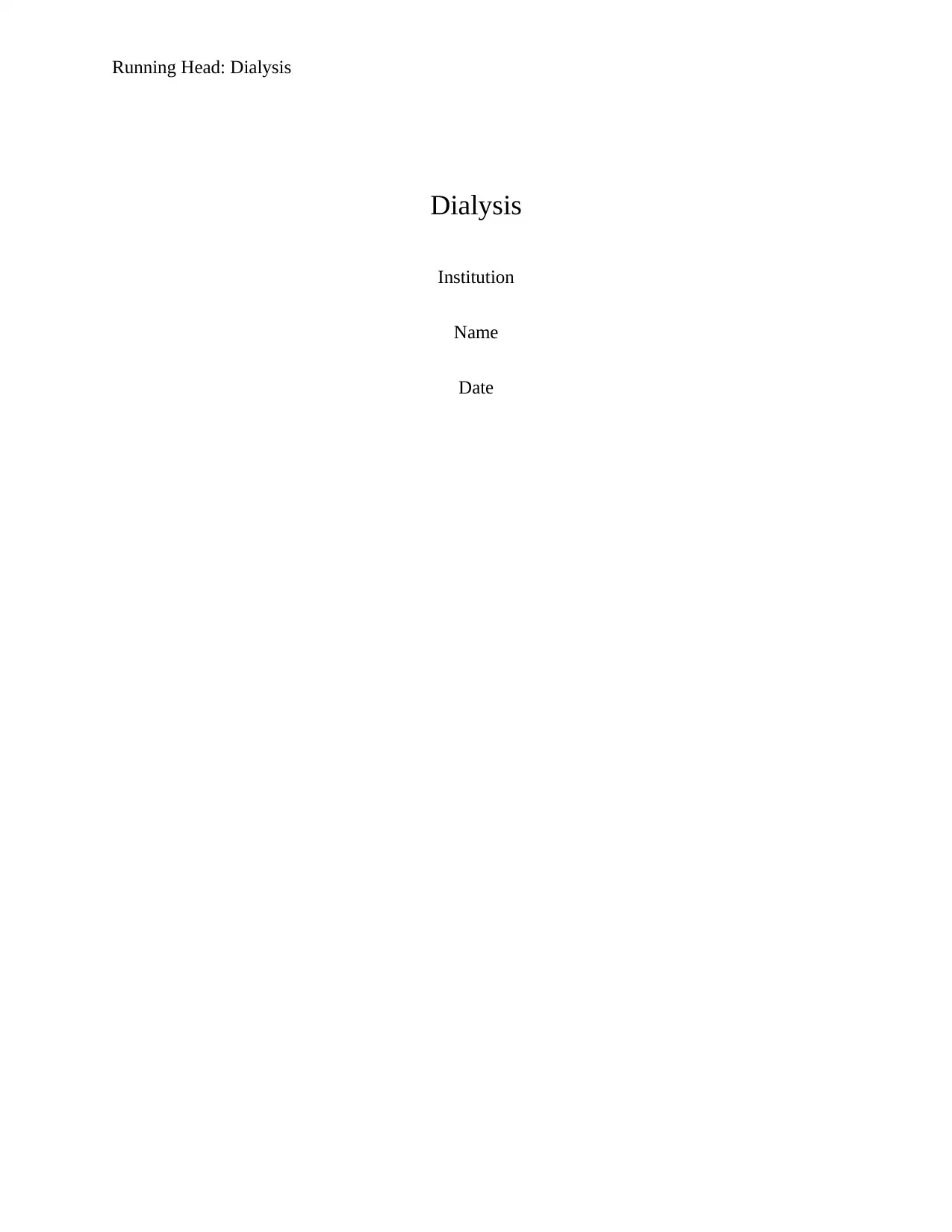
Running Head: Dialysis
Dialysis
Institution
Name
Date
Dialysis
Institution
Name
Date
Paraphrase This Document
Need a fresh take? Get an instant paraphrase of this document with our AI Paraphraser
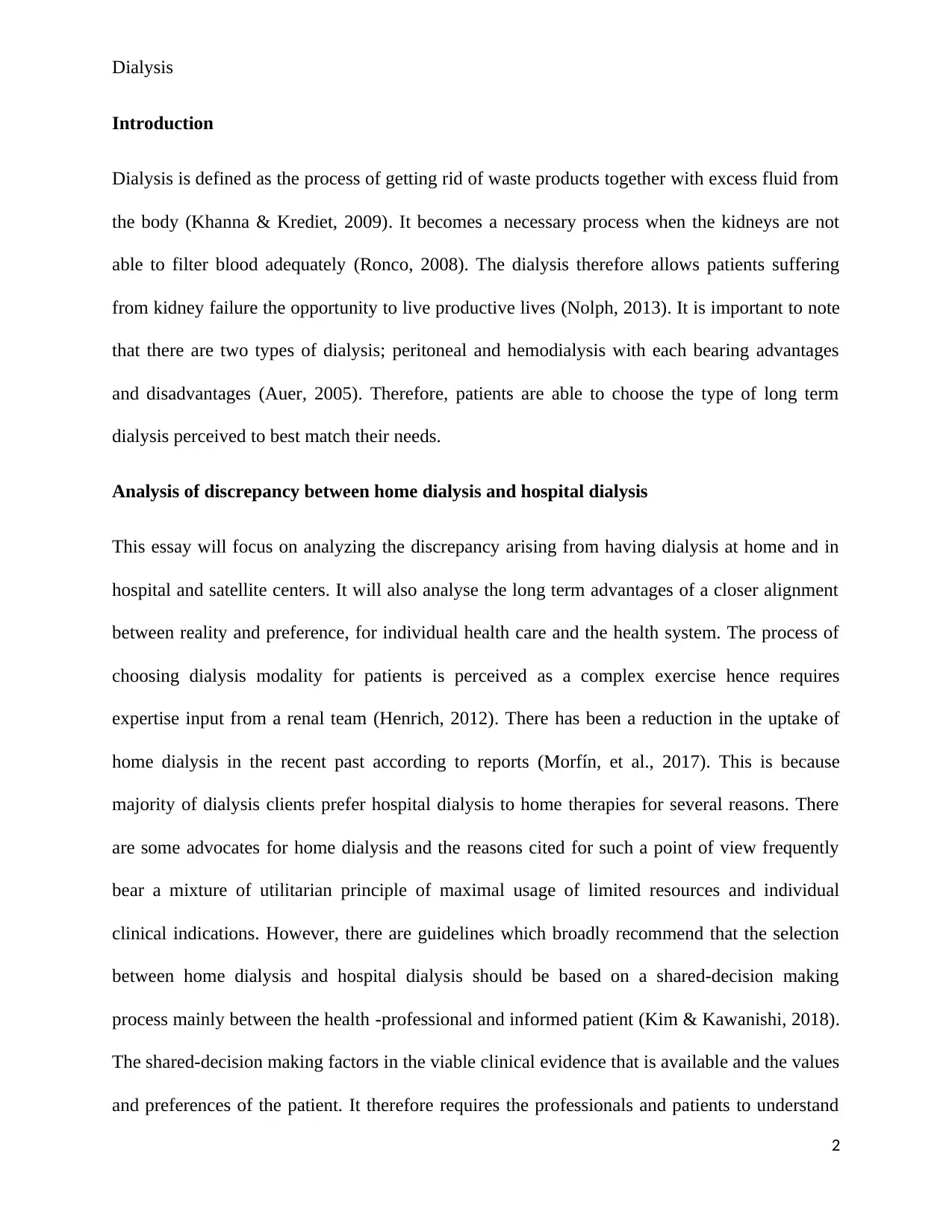
Dialysis
Introduction
Dialysis is defined as the process of getting rid of waste products together with excess fluid from
the body (Khanna & Krediet, 2009). It becomes a necessary process when the kidneys are not
able to filter blood adequately (Ronco, 2008). The dialysis therefore allows patients suffering
from kidney failure the opportunity to live productive lives (Nolph, 2013). It is important to note
that there are two types of dialysis; peritoneal and hemodialysis with each bearing advantages
and disadvantages (Auer, 2005). Therefore, patients are able to choose the type of long term
dialysis perceived to best match their needs.
Analysis of discrepancy between home dialysis and hospital dialysis
This essay will focus on analyzing the discrepancy arising from having dialysis at home and in
hospital and satellite centers. It will also analyse the long term advantages of a closer alignment
between reality and preference, for individual health care and the health system. The process of
choosing dialysis modality for patients is perceived as a complex exercise hence requires
expertise input from a renal team (Henrich, 2012). There has been a reduction in the uptake of
home dialysis in the recent past according to reports (Morfín, et al., 2017). This is because
majority of dialysis clients prefer hospital dialysis to home therapies for several reasons. There
are some advocates for home dialysis and the reasons cited for such a point of view frequently
bear a mixture of utilitarian principle of maximal usage of limited resources and individual
clinical indications. However, there are guidelines which broadly recommend that the selection
between home dialysis and hospital dialysis should be based on a shared-decision making
process mainly between the health -professional and informed patient (Kim & Kawanishi, 2018).
The shared-decision making factors in the viable clinical evidence that is available and the values
and preferences of the patient. It therefore requires the professionals and patients to understand
2
Introduction
Dialysis is defined as the process of getting rid of waste products together with excess fluid from
the body (Khanna & Krediet, 2009). It becomes a necessary process when the kidneys are not
able to filter blood adequately (Ronco, 2008). The dialysis therefore allows patients suffering
from kidney failure the opportunity to live productive lives (Nolph, 2013). It is important to note
that there are two types of dialysis; peritoneal and hemodialysis with each bearing advantages
and disadvantages (Auer, 2005). Therefore, patients are able to choose the type of long term
dialysis perceived to best match their needs.
Analysis of discrepancy between home dialysis and hospital dialysis
This essay will focus on analyzing the discrepancy arising from having dialysis at home and in
hospital and satellite centers. It will also analyse the long term advantages of a closer alignment
between reality and preference, for individual health care and the health system. The process of
choosing dialysis modality for patients is perceived as a complex exercise hence requires
expertise input from a renal team (Henrich, 2012). There has been a reduction in the uptake of
home dialysis in the recent past according to reports (Morfín, et al., 2017). This is because
majority of dialysis clients prefer hospital dialysis to home therapies for several reasons. There
are some advocates for home dialysis and the reasons cited for such a point of view frequently
bear a mixture of utilitarian principle of maximal usage of limited resources and individual
clinical indications. However, there are guidelines which broadly recommend that the selection
between home dialysis and hospital dialysis should be based on a shared-decision making
process mainly between the health -professional and informed patient (Kim & Kawanishi, 2018).
The shared-decision making factors in the viable clinical evidence that is available and the values
and preferences of the patient. It therefore requires the professionals and patients to understand
2
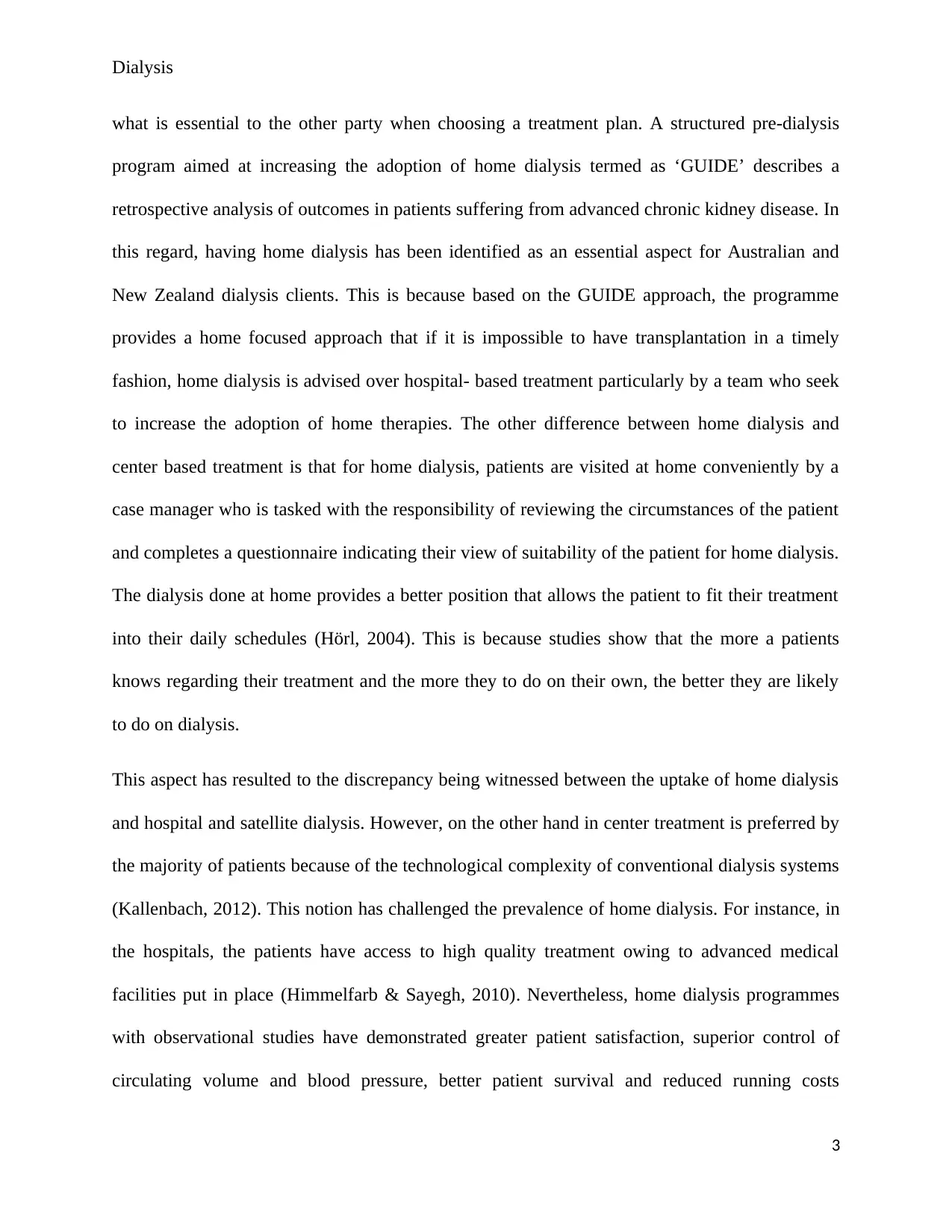
Dialysis
what is essential to the other party when choosing a treatment plan. A structured pre-dialysis
program aimed at increasing the adoption of home dialysis termed as ‘GUIDE’ describes a
retrospective analysis of outcomes in patients suffering from advanced chronic kidney disease. In
this regard, having home dialysis has been identified as an essential aspect for Australian and
New Zealand dialysis clients. This is because based on the GUIDE approach, the programme
provides a home focused approach that if it is impossible to have transplantation in a timely
fashion, home dialysis is advised over hospital- based treatment particularly by a team who seek
to increase the adoption of home therapies. The other difference between home dialysis and
center based treatment is that for home dialysis, patients are visited at home conveniently by a
case manager who is tasked with the responsibility of reviewing the circumstances of the patient
and completes a questionnaire indicating their view of suitability of the patient for home dialysis.
The dialysis done at home provides a better position that allows the patient to fit their treatment
into their daily schedules (Hörl, 2004) . This is because studies show that the more a patients
knows regarding their treatment and the more they to do on their own, the better they are likely
to do on dialysis.
This aspect has resulted to the discrepancy being witnessed between the uptake of home dialysis
and hospital and satellite dialysis. However, on the other hand in center treatment is preferred by
the majority of patients because of the technological complexity of conventional dialysis systems
(Kallenbach, 2012). This notion has challenged the prevalence of home dialysis. For instance, in
the hospitals, the patients have access to high quality treatment owing to advanced medical
facilities put in place (Himmelfarb & Sayegh, 2010). Nevertheless, home dialysis programmes
with observational studies have demonstrated greater patient satisfaction, superior control of
circulating volume and blood pressure, better patient survival and reduced running costs
3
what is essential to the other party when choosing a treatment plan. A structured pre-dialysis
program aimed at increasing the adoption of home dialysis termed as ‘GUIDE’ describes a
retrospective analysis of outcomes in patients suffering from advanced chronic kidney disease. In
this regard, having home dialysis has been identified as an essential aspect for Australian and
New Zealand dialysis clients. This is because based on the GUIDE approach, the programme
provides a home focused approach that if it is impossible to have transplantation in a timely
fashion, home dialysis is advised over hospital- based treatment particularly by a team who seek
to increase the adoption of home therapies. The other difference between home dialysis and
center based treatment is that for home dialysis, patients are visited at home conveniently by a
case manager who is tasked with the responsibility of reviewing the circumstances of the patient
and completes a questionnaire indicating their view of suitability of the patient for home dialysis.
The dialysis done at home provides a better position that allows the patient to fit their treatment
into their daily schedules (Hörl, 2004) . This is because studies show that the more a patients
knows regarding their treatment and the more they to do on their own, the better they are likely
to do on dialysis.
This aspect has resulted to the discrepancy being witnessed between the uptake of home dialysis
and hospital and satellite dialysis. However, on the other hand in center treatment is preferred by
the majority of patients because of the technological complexity of conventional dialysis systems
(Kallenbach, 2012). This notion has challenged the prevalence of home dialysis. For instance, in
the hospitals, the patients have access to high quality treatment owing to advanced medical
facilities put in place (Himmelfarb & Sayegh, 2010). Nevertheless, home dialysis programmes
with observational studies have demonstrated greater patient satisfaction, superior control of
circulating volume and blood pressure, better patient survival and reduced running costs
3
⊘ This is a preview!⊘
Do you want full access?
Subscribe today to unlock all pages.

Trusted by 1+ million students worldwide
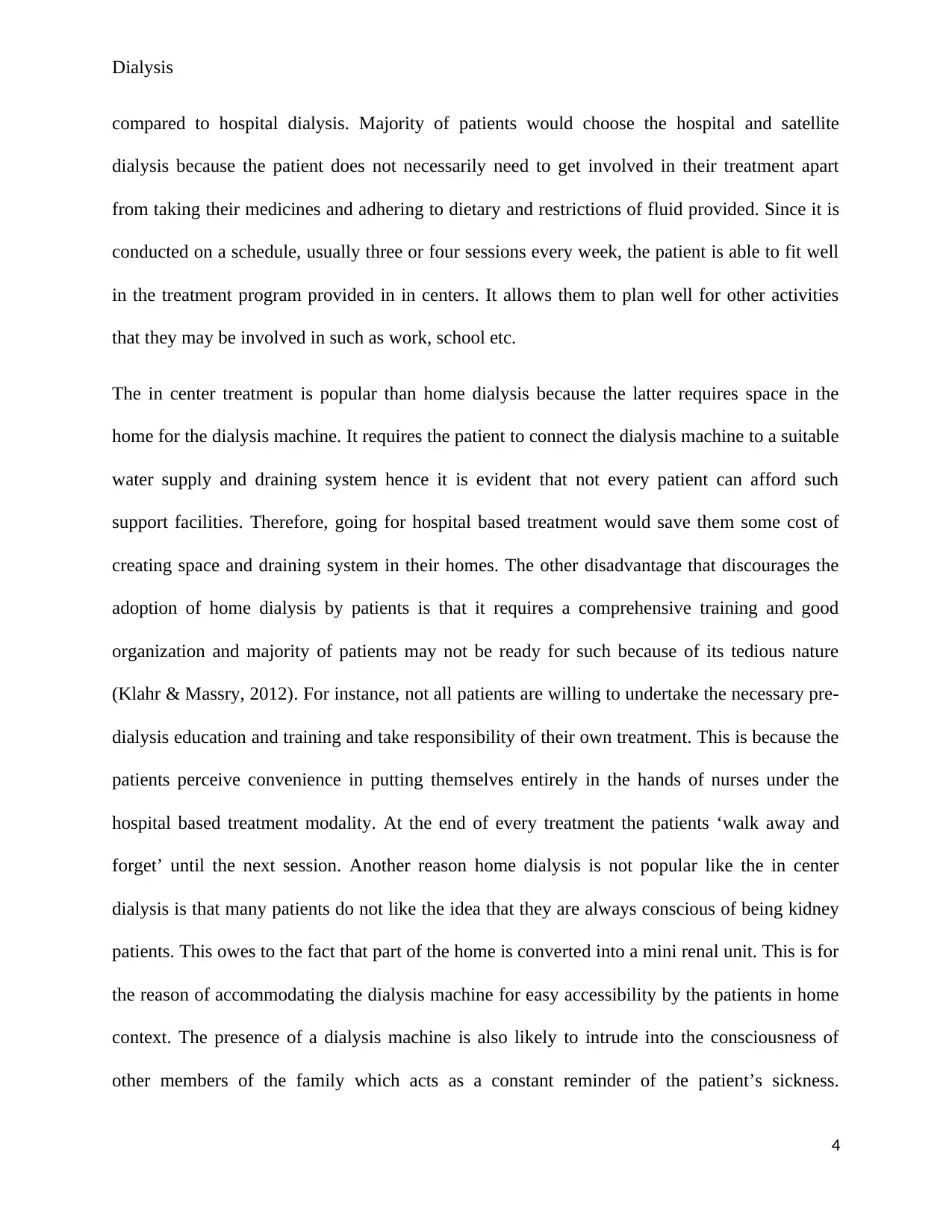
Dialysis
compared to hospital dialysis. Majority of patients would choose the hospital and satellite
dialysis because the patient does not necessarily need to get involved in their treatment apart
from taking their medicines and adhering to dietary and restrictions of fluid provided. Since it is
conducted on a schedule, usually three or four sessions every week, the patient is able to fit well
in the treatment program provided in in centers. It allows them to plan well for other activities
that they may be involved in such as work, school etc.
The in center treatment is popular than home dialysis because the latter requires space in the
home for the dialysis machine. It requires the patient to connect the dialysis machine to a suitable
water supply and draining system hence it is evident that not every patient can afford such
support facilities. Therefore, going for hospital based treatment would save them some cost of
creating space and draining system in their homes. The other disadvantage that discourages the
adoption of home dialysis by patients is that it requires a comprehensive training and good
organization and majority of patients may not be ready for such because of its tedious nature
(Klahr & Massry, 2012). For instance, not all patients are willing to undertake the necessary pre-
dialysis education and training and take responsibility of their own treatment. This is because the
patients perceive convenience in putting themselves entirely in the hands of nurses under the
hospital based treatment modality. At the end of every treatment the patients ‘walk away and
forget’ until the next session. Another reason home dialysis is not popular like the in center
dialysis is that many patients do not like the idea that they are always conscious of being kidney
patients. This owes to the fact that part of the home is converted into a mini renal unit. This is for
the reason of accommodating the dialysis machine for easy accessibility by the patients in home
context. The presence of a dialysis machine is also likely to intrude into the consciousness of
other members of the family which acts as a constant reminder of the patient’s sickness.
4
compared to hospital dialysis. Majority of patients would choose the hospital and satellite
dialysis because the patient does not necessarily need to get involved in their treatment apart
from taking their medicines and adhering to dietary and restrictions of fluid provided. Since it is
conducted on a schedule, usually three or four sessions every week, the patient is able to fit well
in the treatment program provided in in centers. It allows them to plan well for other activities
that they may be involved in such as work, school etc.
The in center treatment is popular than home dialysis because the latter requires space in the
home for the dialysis machine. It requires the patient to connect the dialysis machine to a suitable
water supply and draining system hence it is evident that not every patient can afford such
support facilities. Therefore, going for hospital based treatment would save them some cost of
creating space and draining system in their homes. The other disadvantage that discourages the
adoption of home dialysis by patients is that it requires a comprehensive training and good
organization and majority of patients may not be ready for such because of its tedious nature
(Klahr & Massry, 2012). For instance, not all patients are willing to undertake the necessary pre-
dialysis education and training and take responsibility of their own treatment. This is because the
patients perceive convenience in putting themselves entirely in the hands of nurses under the
hospital based treatment modality. At the end of every treatment the patients ‘walk away and
forget’ until the next session. Another reason home dialysis is not popular like the in center
dialysis is that many patients do not like the idea that they are always conscious of being kidney
patients. This owes to the fact that part of the home is converted into a mini renal unit. This is for
the reason of accommodating the dialysis machine for easy accessibility by the patients in home
context. The presence of a dialysis machine is also likely to intrude into the consciousness of
other members of the family which acts as a constant reminder of the patient’s sickness.
4
Paraphrase This Document
Need a fresh take? Get an instant paraphrase of this document with our AI Paraphraser
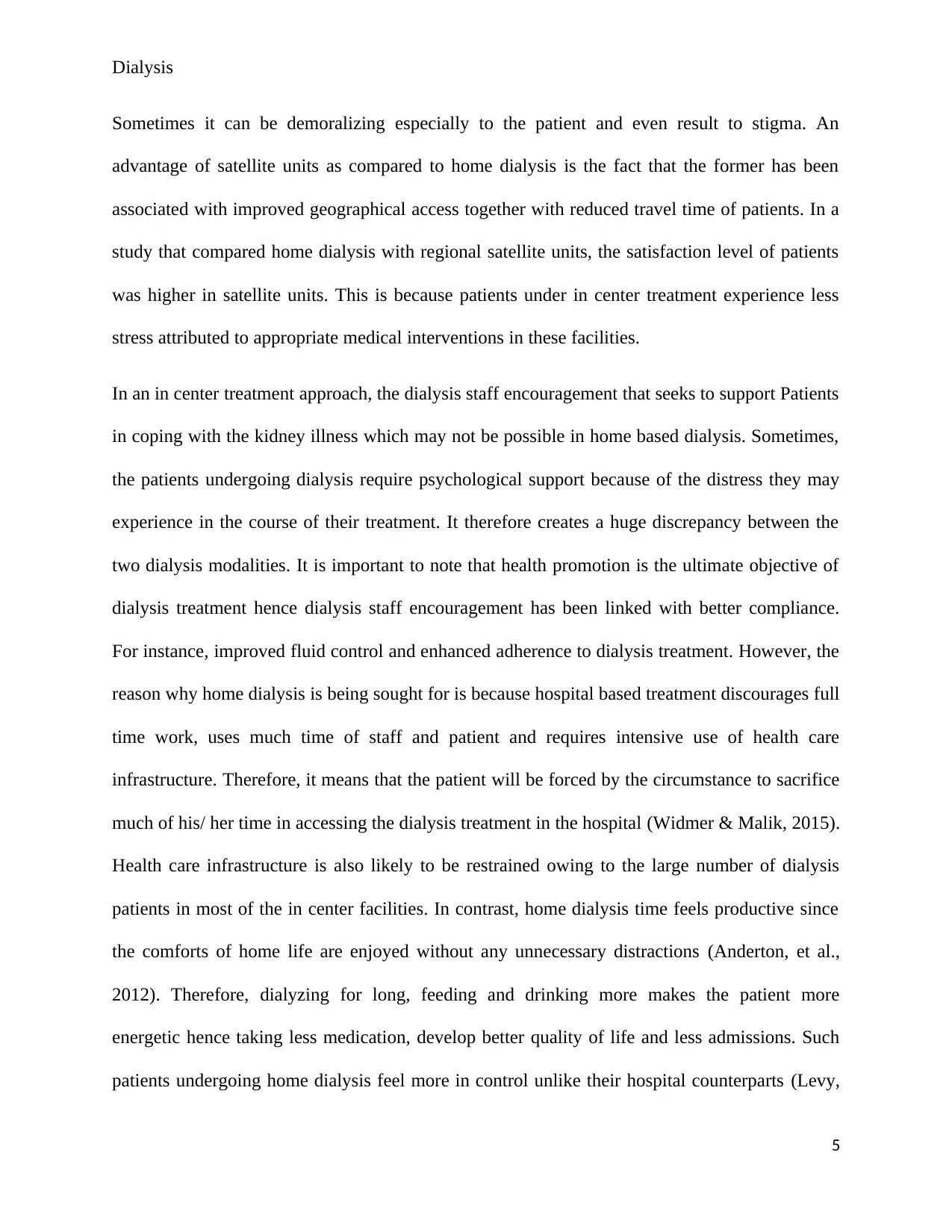
Dialysis
Sometimes it can be demoralizing especially to the patient and even result to stigma. An
advantage of satellite units as compared to home dialysis is the fact that the former has been
associated with improved geographical access together with reduced travel time of patients. In a
study that compared home dialysis with regional satellite units, the satisfaction level of patients
was higher in satellite units. This is because patients under in center treatment experience less
stress attributed to appropriate medical interventions in these facilities.
In an in center treatment approach, the dialysis staff encouragement that seeks to support Patients
in coping with the kidney illness which may not be possible in home based dialysis. Sometimes,
the patients undergoing dialysis require psychological support because of the distress they may
experience in the course of their treatment. It therefore creates a huge discrepancy between the
two dialysis modalities. It is important to note that health promotion is the ultimate objective of
dialysis treatment hence dialysis staff encouragement has been linked with better compliance.
For instance, improved fluid control and enhanced adherence to dialysis treatment. However, the
reason why home dialysis is being sought for is because hospital based treatment discourages full
time work, uses much time of staff and patient and requires intensive use of health care
infrastructure. Therefore, it means that the patient will be forced by the circumstance to sacrifice
much of his/ her time in accessing the dialysis treatment in the hospital (Widmer & Malik, 2015).
Health care infrastructure is also likely to be restrained owing to the large number of dialysis
patients in most of the in center facilities. In contrast, home dialysis time feels productive since
the comforts of home life are enjoyed without any unnecessary distractions (Anderton, et al.,
2012). Therefore, dialyzing for long, feeding and drinking more makes the patient more
energetic hence taking less medication, develop better quality of life and less admissions. Such
patients undergoing home dialysis feel more in control unlike their hospital counterparts (Levy,
5
Sometimes it can be demoralizing especially to the patient and even result to stigma. An
advantage of satellite units as compared to home dialysis is the fact that the former has been
associated with improved geographical access together with reduced travel time of patients. In a
study that compared home dialysis with regional satellite units, the satisfaction level of patients
was higher in satellite units. This is because patients under in center treatment experience less
stress attributed to appropriate medical interventions in these facilities.
In an in center treatment approach, the dialysis staff encouragement that seeks to support Patients
in coping with the kidney illness which may not be possible in home based dialysis. Sometimes,
the patients undergoing dialysis require psychological support because of the distress they may
experience in the course of their treatment. It therefore creates a huge discrepancy between the
two dialysis modalities. It is important to note that health promotion is the ultimate objective of
dialysis treatment hence dialysis staff encouragement has been linked with better compliance.
For instance, improved fluid control and enhanced adherence to dialysis treatment. However, the
reason why home dialysis is being sought for is because hospital based treatment discourages full
time work, uses much time of staff and patient and requires intensive use of health care
infrastructure. Therefore, it means that the patient will be forced by the circumstance to sacrifice
much of his/ her time in accessing the dialysis treatment in the hospital (Widmer & Malik, 2015).
Health care infrastructure is also likely to be restrained owing to the large number of dialysis
patients in most of the in center facilities. In contrast, home dialysis time feels productive since
the comforts of home life are enjoyed without any unnecessary distractions (Anderton, et al.,
2012). Therefore, dialyzing for long, feeding and drinking more makes the patient more
energetic hence taking less medication, develop better quality of life and less admissions. Such
patients undergoing home dialysis feel more in control unlike their hospital counterparts (Levy,
5
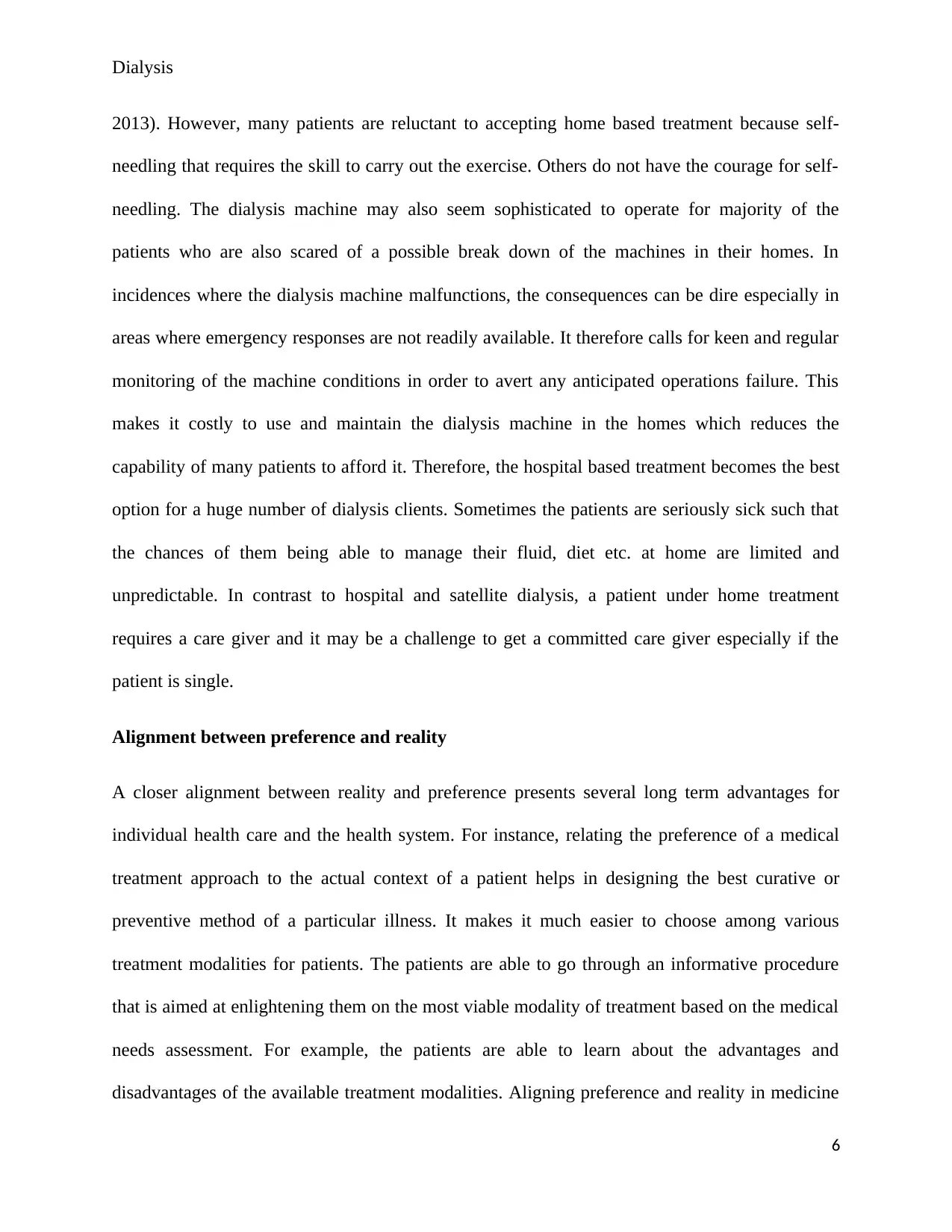
Dialysis
2013). However, many patients are reluctant to accepting home based treatment because self-
needling that requires the skill to carry out the exercise. Others do not have the courage for self-
needling. The dialysis machine may also seem sophisticated to operate for majority of the
patients who are also scared of a possible break down of the machines in their homes. In
incidences where the dialysis machine malfunctions, the consequences can be dire especially in
areas where emergency responses are not readily available. It therefore calls for keen and regular
monitoring of the machine conditions in order to avert any anticipated operations failure. This
makes it costly to use and maintain the dialysis machine in the homes which reduces the
capability of many patients to afford it. Therefore, the hospital based treatment becomes the best
option for a huge number of dialysis clients. Sometimes the patients are seriously sick such that
the chances of them being able to manage their fluid, diet etc. at home are limited and
unpredictable. In contrast to hospital and satellite dialysis, a patient under home treatment
requires a care giver and it may be a challenge to get a committed care giver especially if the
patient is single.
Alignment between preference and reality
A closer alignment between reality and preference presents several long term advantages for
individual health care and the health system. For instance, relating the preference of a medical
treatment approach to the actual context of a patient helps in designing the best curative or
preventive method of a particular illness. It makes it much easier to choose among various
treatment modalities for patients. The patients are able to go through an informative procedure
that is aimed at enlightening them on the most viable modality of treatment based on the medical
needs assessment. For example, the patients are able to learn about the advantages and
disadvantages of the available treatment modalities. Aligning preference and reality in medicine
6
2013). However, many patients are reluctant to accepting home based treatment because self-
needling that requires the skill to carry out the exercise. Others do not have the courage for self-
needling. The dialysis machine may also seem sophisticated to operate for majority of the
patients who are also scared of a possible break down of the machines in their homes. In
incidences where the dialysis machine malfunctions, the consequences can be dire especially in
areas where emergency responses are not readily available. It therefore calls for keen and regular
monitoring of the machine conditions in order to avert any anticipated operations failure. This
makes it costly to use and maintain the dialysis machine in the homes which reduces the
capability of many patients to afford it. Therefore, the hospital based treatment becomes the best
option for a huge number of dialysis clients. Sometimes the patients are seriously sick such that
the chances of them being able to manage their fluid, diet etc. at home are limited and
unpredictable. In contrast to hospital and satellite dialysis, a patient under home treatment
requires a care giver and it may be a challenge to get a committed care giver especially if the
patient is single.
Alignment between preference and reality
A closer alignment between reality and preference presents several long term advantages for
individual health care and the health system. For instance, relating the preference of a medical
treatment approach to the actual context of a patient helps in designing the best curative or
preventive method of a particular illness. It makes it much easier to choose among various
treatment modalities for patients. The patients are able to go through an informative procedure
that is aimed at enlightening them on the most viable modality of treatment based on the medical
needs assessment. For example, the patients are able to learn about the advantages and
disadvantages of the available treatment modalities. Aligning preference and reality in medicine
6
⊘ This is a preview!⊘
Do you want full access?
Subscribe today to unlock all pages.

Trusted by 1+ million students worldwide
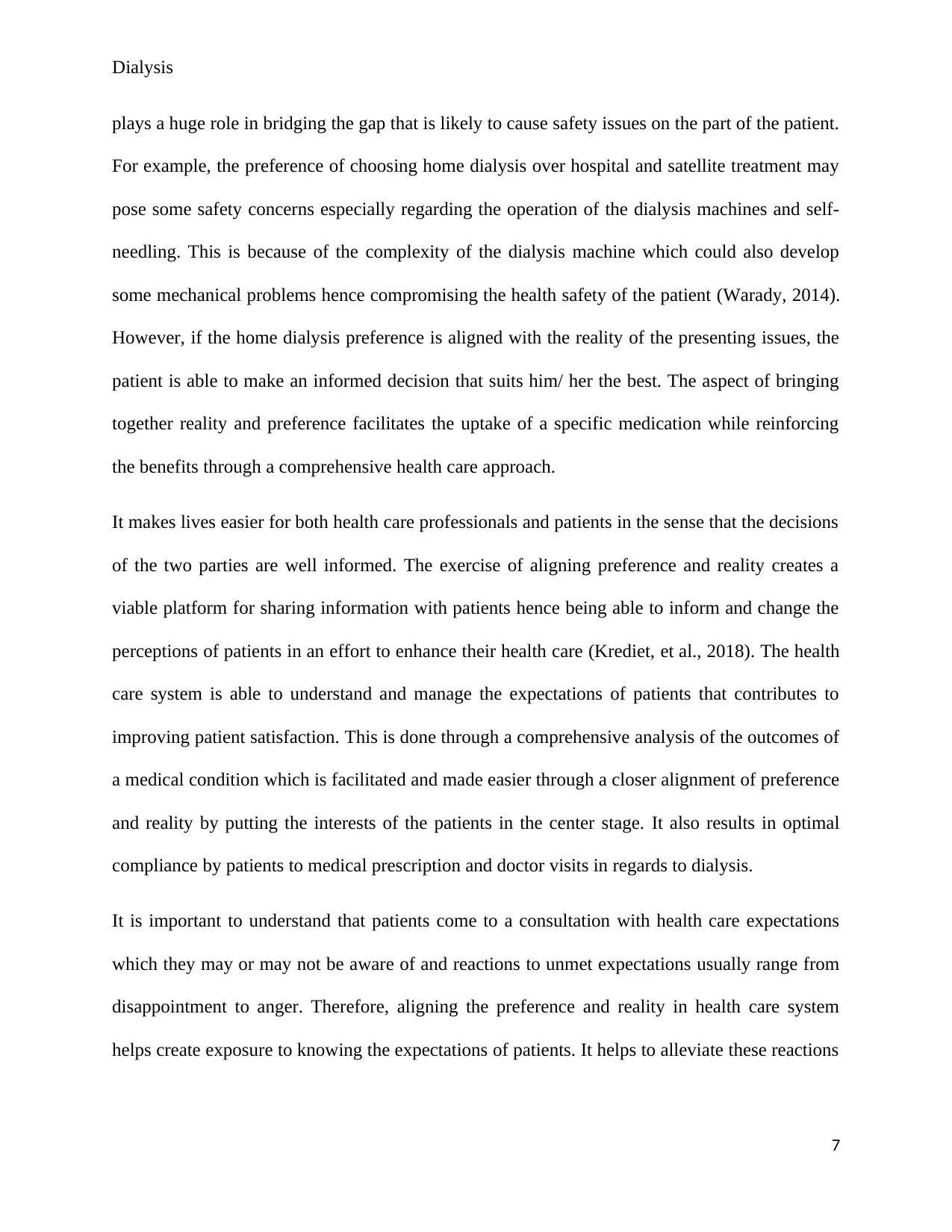
Dialysis
plays a huge role in bridging the gap that is likely to cause safety issues on the part of the patient.
For example, the preference of choosing home dialysis over hospital and satellite treatment may
pose some safety concerns especially regarding the operation of the dialysis machines and self-
needling. This is because of the complexity of the dialysis machine which could also develop
some mechanical problems hence compromising the health safety of the patient (Warady, 2014).
However, if the home dialysis preference is aligned with the reality of the presenting issues, the
patient is able to make an informed decision that suits him/ her the best. The aspect of bringing
together reality and preference facilitates the uptake of a specific medication while reinforcing
the benefits through a comprehensive health care approach.
It makes lives easier for both health care professionals and patients in the sense that the decisions
of the two parties are well informed. The exercise of aligning preference and reality creates a
viable platform for sharing information with patients hence being able to inform and change the
perceptions of patients in an effort to enhance their health care (Krediet, et al., 2018). The health
care system is able to understand and manage the expectations of patients that contributes to
improving patient satisfaction. This is done through a comprehensive analysis of the outcomes of
a medical condition which is facilitated and made easier through a closer alignment of preference
and reality by putting the interests of the patients in the center stage. It also results in optimal
compliance by patients to medical prescription and doctor visits in regards to dialysis.
It is important to understand that patients come to a consultation with health care expectations
which they may or may not be aware of and reactions to unmet expectations usually range from
disappointment to anger. Therefore, aligning the preference and reality in health care system
helps create exposure to knowing the expectations of patients. It helps to alleviate these reactions
7
plays a huge role in bridging the gap that is likely to cause safety issues on the part of the patient.
For example, the preference of choosing home dialysis over hospital and satellite treatment may
pose some safety concerns especially regarding the operation of the dialysis machines and self-
needling. This is because of the complexity of the dialysis machine which could also develop
some mechanical problems hence compromising the health safety of the patient (Warady, 2014).
However, if the home dialysis preference is aligned with the reality of the presenting issues, the
patient is able to make an informed decision that suits him/ her the best. The aspect of bringing
together reality and preference facilitates the uptake of a specific medication while reinforcing
the benefits through a comprehensive health care approach.
It makes lives easier for both health care professionals and patients in the sense that the decisions
of the two parties are well informed. The exercise of aligning preference and reality creates a
viable platform for sharing information with patients hence being able to inform and change the
perceptions of patients in an effort to enhance their health care (Krediet, et al., 2018). The health
care system is able to understand and manage the expectations of patients that contributes to
improving patient satisfaction. This is done through a comprehensive analysis of the outcomes of
a medical condition which is facilitated and made easier through a closer alignment of preference
and reality by putting the interests of the patients in the center stage. It also results in optimal
compliance by patients to medical prescription and doctor visits in regards to dialysis.
It is important to understand that patients come to a consultation with health care expectations
which they may or may not be aware of and reactions to unmet expectations usually range from
disappointment to anger. Therefore, aligning the preference and reality in health care system
helps create exposure to knowing the expectations of patients. It helps to alleviate these reactions
7
Paraphrase This Document
Need a fresh take? Get an instant paraphrase of this document with our AI Paraphraser
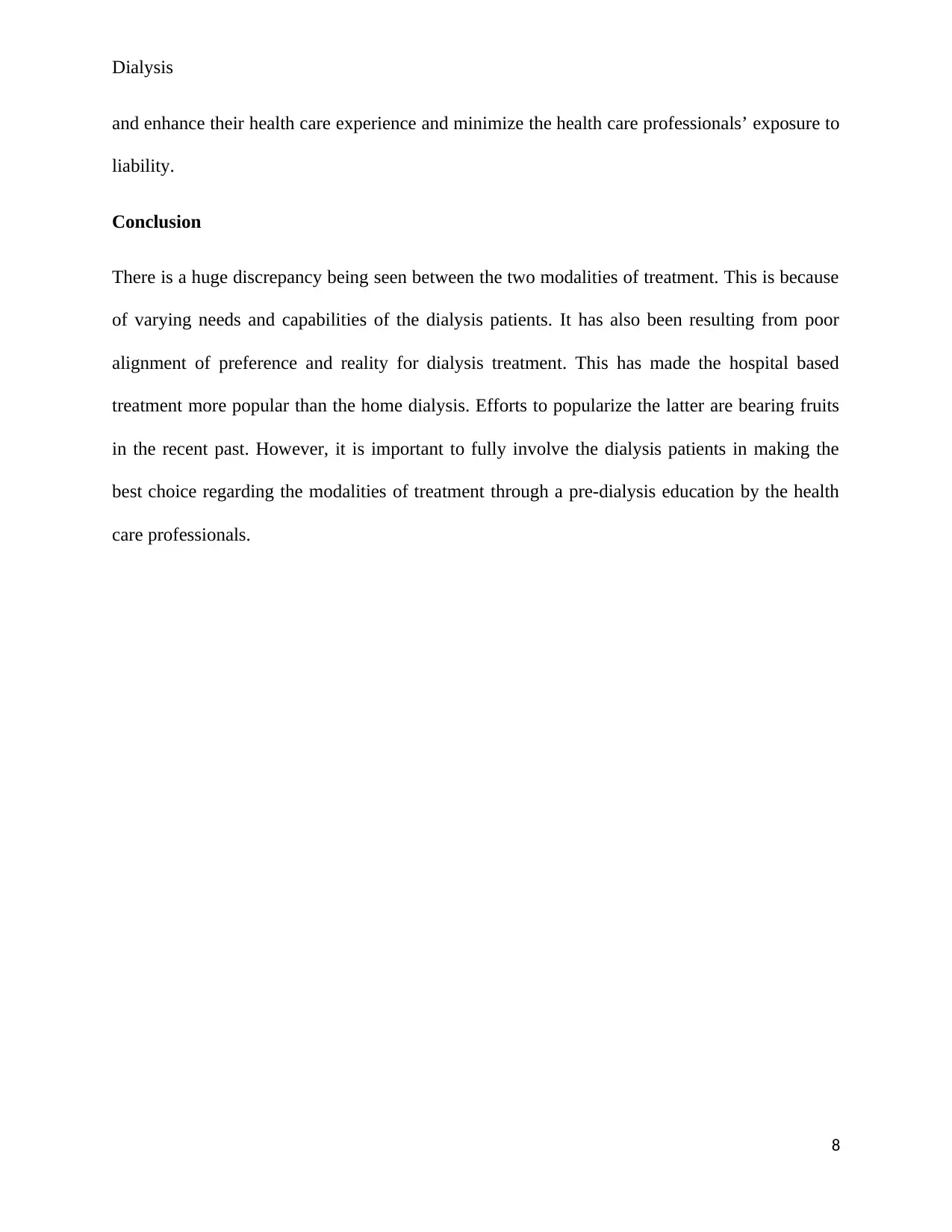
Dialysis
and enhance their health care experience and minimize the health care professionals’ exposure to
liability.
Conclusion
There is a huge discrepancy being seen between the two modalities of treatment. This is because
of varying needs and capabilities of the dialysis patients. It has also been resulting from poor
alignment of preference and reality for dialysis treatment. This has made the hospital based
treatment more popular than the home dialysis. Efforts to popularize the latter are bearing fruits
in the recent past. However, it is important to fully involve the dialysis patients in making the
best choice regarding the modalities of treatment through a pre-dialysis education by the health
care professionals.
8
and enhance their health care experience and minimize the health care professionals’ exposure to
liability.
Conclusion
There is a huge discrepancy being seen between the two modalities of treatment. This is because
of varying needs and capabilities of the dialysis patients. It has also been resulting from poor
alignment of preference and reality for dialysis treatment. This has made the hospital based
treatment more popular than the home dialysis. Efforts to popularize the latter are bearing fruits
in the recent past. However, it is important to fully involve the dialysis patients in making the
best choice regarding the modalities of treatment through a pre-dialysis education by the health
care professionals.
8
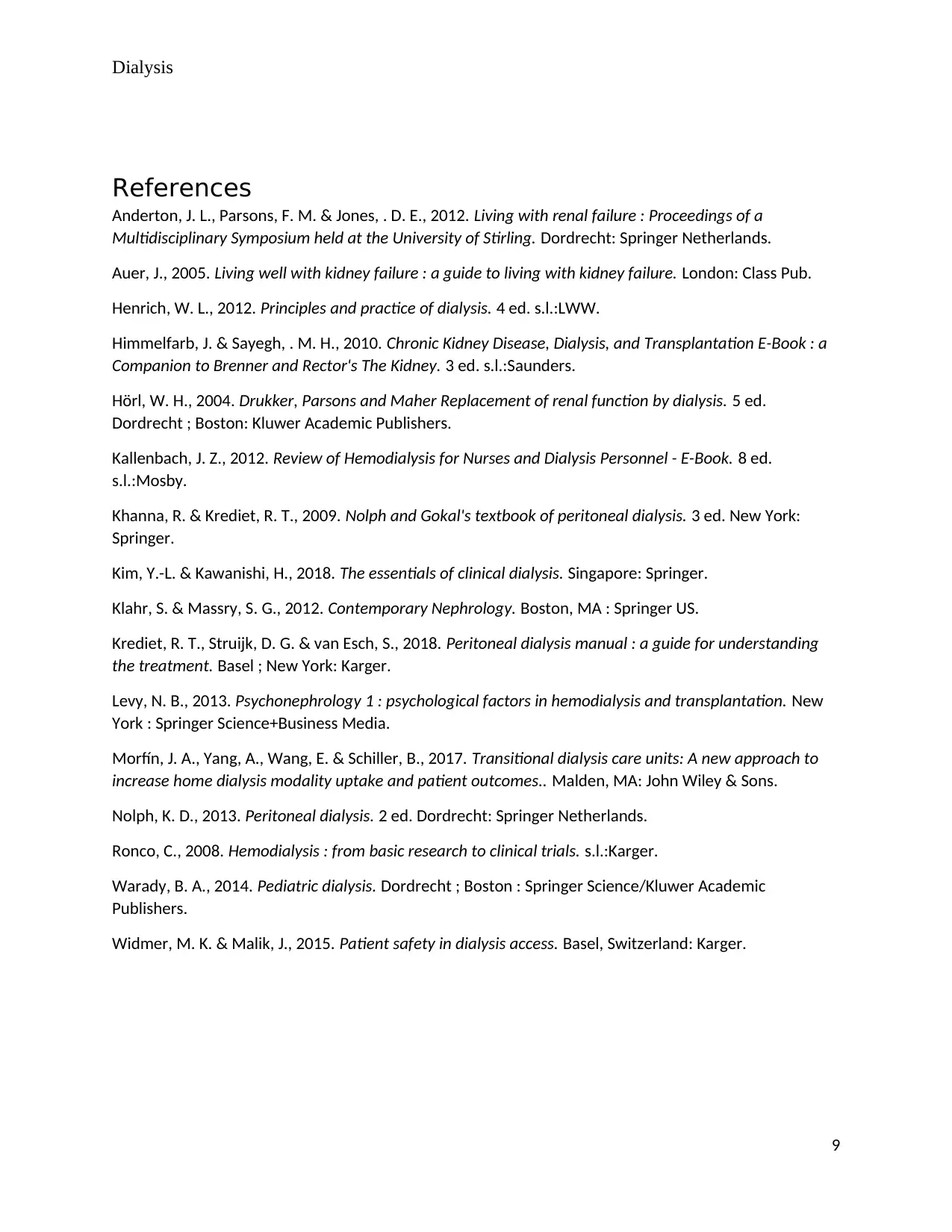
Dialysis
References
Anderton, J. L., Parsons, F. M. & Jones, . D. E., 2012. Living with renal failure : Proceedings of a
Multidisciplinary Symposium held at the University of Stirling. Dordrecht: Springer Netherlands.
Auer, J., 2005. Living well with kidney failure : a guide to living with kidney failure. London: Class Pub.
Henrich, W. L., 2012. Principles and practice of dialysis. 4 ed. s.l.:LWW.
Himmelfarb, J. & Sayegh, . M. H., 2010. Chronic Kidney Disease, Dialysis, and Transplantation E-Book : a
Companion to Brenner and Rector's The Kidney. 3 ed. s.l.:Saunders.
Hörl, W. H., 2004. Drukker, Parsons and Maher Replacement of renal function by dialysis. 5 ed.
Dordrecht ; Boston: Kluwer Academic Publishers.
Kallenbach, J. Z., 2012. Review of Hemodialysis for Nurses and Dialysis Personnel - E-Book. 8 ed.
s.l.:Mosby.
Khanna, R. & Krediet, R. T., 2009. Nolph and Gokal's textbook of peritoneal dialysis. 3 ed. New York:
Springer.
Kim, Y.-L. & Kawanishi, H., 2018. The essentials of clinical dialysis. Singapore: Springer.
Klahr, S. & Massry, S. G., 2012. Contemporary Nephrology. Boston, MA : Springer US.
Krediet, R. T., Struijk, D. G. & van Esch, S., 2018. Peritoneal dialysis manual : a guide for understanding
the treatment. Basel ; New York: Karger.
Levy, N. B., 2013. Psychonephrology 1 : psychological factors in hemodialysis and transplantation. New
York : Springer Science+Business Media.
Morfín, J. A., Yang, A., Wang, E. & Schiller, B., 2017. Transitional dialysis care units: A new approach to
increase home dialysis modality uptake and patient outcomes.. Malden, MA: John Wiley & Sons.
Nolph, K. D., 2013. Peritoneal dialysis. 2 ed. Dordrecht: Springer Netherlands.
Ronco, C., 2008. Hemodialysis : from basic research to clinical trials. s.l.:Karger.
Warady, B. A., 2014. Pediatric dialysis. Dordrecht ; Boston : Springer Science/Kluwer Academic
Publishers.
Widmer, M. K. & Malik, J., 2015. Patient safety in dialysis access. Basel, Switzerland: Karger.
9
References
Anderton, J. L., Parsons, F. M. & Jones, . D. E., 2012. Living with renal failure : Proceedings of a
Multidisciplinary Symposium held at the University of Stirling. Dordrecht: Springer Netherlands.
Auer, J., 2005. Living well with kidney failure : a guide to living with kidney failure. London: Class Pub.
Henrich, W. L., 2012. Principles and practice of dialysis. 4 ed. s.l.:LWW.
Himmelfarb, J. & Sayegh, . M. H., 2010. Chronic Kidney Disease, Dialysis, and Transplantation E-Book : a
Companion to Brenner and Rector's The Kidney. 3 ed. s.l.:Saunders.
Hörl, W. H., 2004. Drukker, Parsons and Maher Replacement of renal function by dialysis. 5 ed.
Dordrecht ; Boston: Kluwer Academic Publishers.
Kallenbach, J. Z., 2012. Review of Hemodialysis for Nurses and Dialysis Personnel - E-Book. 8 ed.
s.l.:Mosby.
Khanna, R. & Krediet, R. T., 2009. Nolph and Gokal's textbook of peritoneal dialysis. 3 ed. New York:
Springer.
Kim, Y.-L. & Kawanishi, H., 2018. The essentials of clinical dialysis. Singapore: Springer.
Klahr, S. & Massry, S. G., 2012. Contemporary Nephrology. Boston, MA : Springer US.
Krediet, R. T., Struijk, D. G. & van Esch, S., 2018. Peritoneal dialysis manual : a guide for understanding
the treatment. Basel ; New York: Karger.
Levy, N. B., 2013. Psychonephrology 1 : psychological factors in hemodialysis and transplantation. New
York : Springer Science+Business Media.
Morfín, J. A., Yang, A., Wang, E. & Schiller, B., 2017. Transitional dialysis care units: A new approach to
increase home dialysis modality uptake and patient outcomes.. Malden, MA: John Wiley & Sons.
Nolph, K. D., 2013. Peritoneal dialysis. 2 ed. Dordrecht: Springer Netherlands.
Ronco, C., 2008. Hemodialysis : from basic research to clinical trials. s.l.:Karger.
Warady, B. A., 2014. Pediatric dialysis. Dordrecht ; Boston : Springer Science/Kluwer Academic
Publishers.
Widmer, M. K. & Malik, J., 2015. Patient safety in dialysis access. Basel, Switzerland: Karger.
9
⊘ This is a preview!⊘
Do you want full access?
Subscribe today to unlock all pages.

Trusted by 1+ million students worldwide
1 out of 9
Related Documents
Your All-in-One AI-Powered Toolkit for Academic Success.
+13062052269
info@desklib.com
Available 24*7 on WhatsApp / Email
![[object Object]](/_next/static/media/star-bottom.7253800d.svg)
Unlock your academic potential
Copyright © 2020–2025 A2Z Services. All Rights Reserved. Developed and managed by ZUCOL.




